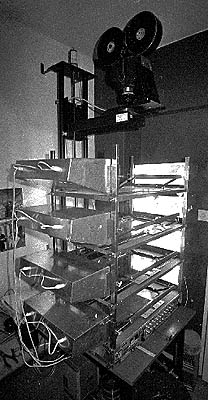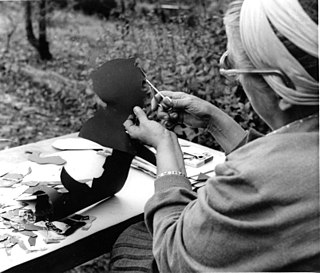
Animation is a filmmaking technique by which still images are manipulated to create moving images. In traditional animation, images are drawn or painted by hand on transparent celluloid sheets (cels) to be photographed and exhibited on film. Animation has been recognized as an artistic medium, specifically within the entertainment industry. Many animations are computer animations made with computer-generated imagery (CGI). Stop motion animation, in particular claymation, has continued to exist alongside these other forms.
While the history of animation began much earlier, this article is concerned with the development of the medium after the emergence of celluloid film in 1888, as produced for theatrical screenings, television and (non-interactive) home video.

Charlotte "Lotte" Reiniger was a German film director and the foremost pioneer of silhouette animation. Her best known films are The Adventures of Prince Achmed, from 1926, the oldest surviving feature-length animated film, and Papageno (1935). Reiniger is also noted for having devised, from 1923 to 1926, the first form of a multiplane camera, one of the most important devices in pre digital animation. Reiniger worked on more than 40 films throughout her career.

Traditional animation is an animation technique in which each frame is drawn by hand. The technique was the dominant form of animation, until the final few years of the 20th century, when there was a shift to computer animation in the industry, specifically 3D computer animation.

Cutout animation is a form of stop-motion animation using flat characters, props and backgrounds cut from materials such as paper, card, stiff fabric or photographs. The props would be cut out and used as puppets for stop motion. The world's earliest known animated feature films were cutout animations, as is the world's earliest surviving animated feature Die Abenteuer des Prinzen Achmed (1926) by Lotte Reiniger.

Hiroyuki Imaishi is a Japanese anime director, animator and co-founder of Studio Trigger. His style is marked by fast and frantic animation combined with elaborate storyboarding and punchy direction. Prior to founding Trigger, he was an animator and director at Gainax. His most well-known works include Gurren Lagann (2007), Panty and Stocking with Garterbelt (2010), Kill la Kill (2013), Promare (2019), and Cyberpunk: Edgerunners (2022).

The multiplane camera is a motion-picture camera that was used in the traditional animation process that moves a number of pieces of artwork past the camera at various speeds and at various distances from one another. This creates a sense of parallax or depth.

The Annie Awards are accolades which the Los Angeles branch of the International Animated Film Association, ASIFA-Hollywood, has presented each year since 1972 to recognize excellence in animation shown in American cinema and television. Originally designed to celebrate lifetime or career contributions to animation, the award has been given to individual works since 1992.
Paul Rudish is an American animator, storyboard artist, writer, and voice actor, originally known for his art, writing, and design work at Cartoon Network Studios on series created by Genndy Tartakovsky. He went on to co-create the series Sym-Bionic Titan and, in 2013, developed, wrote, storyboarded, executive produced, and directed a revival of Mickey Mouse short cartoons.

Silhouette animation is animation in which the characters are only visible as black silhouettes. This is usually accomplished by backlighting articulated cardboard cut-outs, though other methods exist. It is partially inspired by, but for a number of reasons technically distinct from, shadow play.

Michel Ocelot is a French writer, designer, storyboard artist and director of animated films and television programs and a former president of the International Animated Film Association. Though best known for his 1998 debut feature Kirikou and the Sorceress, his earlier films and television work had already won Césars and British Academy Film Awards among others and he was made a chevalier of the Légion d'honneur on 23 October 2009, presented to him by Agnès Varda who had been promoted to commandeur earlier the same year. In 2015 he got the Lifetime Achievement Award at the World Festival of Animated Film - Animafest Zagreb.
Ralph Zondag is a Canadian animator, storyboard artist, and director.

Nora Twomey is an Irish animator, director, screenwriter, producer and voice actress. She is best known as the co-founder of Cartoon Saloon, alongside Tomm Moore and Paul Young, an animation studio and production company, based in Kilkenny City, Ireland. She is best known for co-directing The Secret of Kells and directing The Breadwinner. Her work on both films earned Academy Award nominations for Best Animated Feature.
Nicholas Robert Jennings is an American director, artist, writer, and producer best known for his work on the Nickelodeon shows Rocko's Modern Life and SpongeBob SquarePants, as well as the Cartoon Network series Adventure Time. He has also worked as a background artist for many animated television series.

"Bad Jubies" is the twentieth episode of the seventh season of the American animated television series Adventure Time. The episode was written, storyboarded, and directed by Kirsten Lepore, and filmed entirely via stop motion. It originally aired on Cartoon Network on January 14, 2016. The episode guest stars Kevin Michael Richardson as both a sentient storm and an automated weather alert system.
The 23rd Annie Awards were given by the International Animated Film Association to honor outstanding achievements in animation in 1995. Pocahontas led the nominations with 7 and won 4 awards, including Best Animated Feature. The Simpsons won its fourth consecutive award for Best Animated Television Program.
The Annie Award for Character Animation in an Animated Feature Production is an Annie Award awarded annually to the best character animator and introduced in 1995. It rewards animation of characters for animated feature films.
The Annie Award for Best Production Design in an Animated Feature Production is an Annie Award first presented in 1994. Since then, it is annually awarded to the animation industry's best or excellent work performed in the areas of overall production design and art direction for sets of animated feature films.
The Annie Award for Production Design in an Animated Television/Broadcast Production is an Annie Award given annually to the best production design in animated television or broadcasting productions. Prior to the creation of the category in 1997, television productions competed alongside feature films in the Best Individual Achievement for Artistic Excellence in the Field of Animation award, presented in 1994, later renamed Best Individual Achievement for Production Design in the Field of Animation to for 1995 and 1996.










